From - Sky & Telescope
By - Bob King
Edited by - Amal Udawatta,
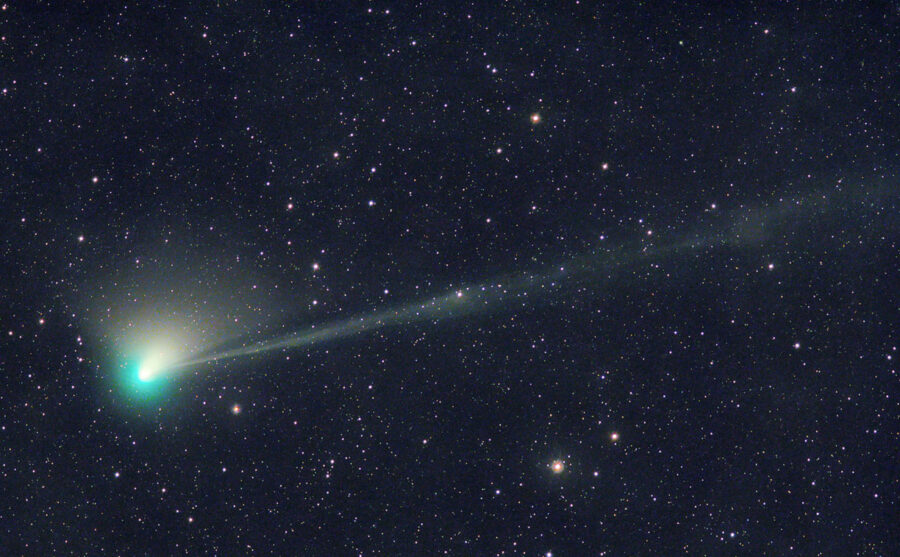
Michael Jaeger
Dazzling green comet! First appearance in 50,000 years! Watch it streak across the sky! Based on recent headlines you’d think Comet ZTF (C/2022 E3) was the greatest astronomical event of modern times. While it’s not all that, this Oort Cloud refugee is already visible in binoculars and a pretty sight in modest telescopes. Observers with dark, moonless skies may even spot the comet with the naked eye (dimly) as it sails between the the Big and Little Dippers later this month. Thanks to clouds and moonlight I last saw it in late December at 8th magnitude in Corona Borealis.
Current visual magnitude estimates put Comet ZTF at between magnitude 6.5 and 7.0. Expect it to peak around magnitude 5.5 at the end of January into early February. Not to throw shade, but Jose Pablo Navarro, amateur astronomer and administrator of the Facebook group Comet Asteroid Meteor Watch, examined 2,509 visual and CCD observations of the comet from the Minor Planet Center database. His analysis indicates a recent slowdown in the comet's rate of brightening, with a peak brightness closer to 6.0 magnitude. Time will tell.

Michael Jaeger
Photographs show a striking blue-green coma, a feature often seen in comets that journey into the inner solar system. Solar ultraviolet (UV) light breaks down large organic molecules boiling off the nucleus into simpler compounds, including green-glowing diatomic carbon (C2). Within a couple of days, that same energetic light destroys the molecule before it has time to leave the coma, preventing it from traveling into the comet’s tail and tinging it green. Sometimes the delightful Caribbean hue is subtly visible in binoculars, but normally a 6-inch or larger telescope is required.
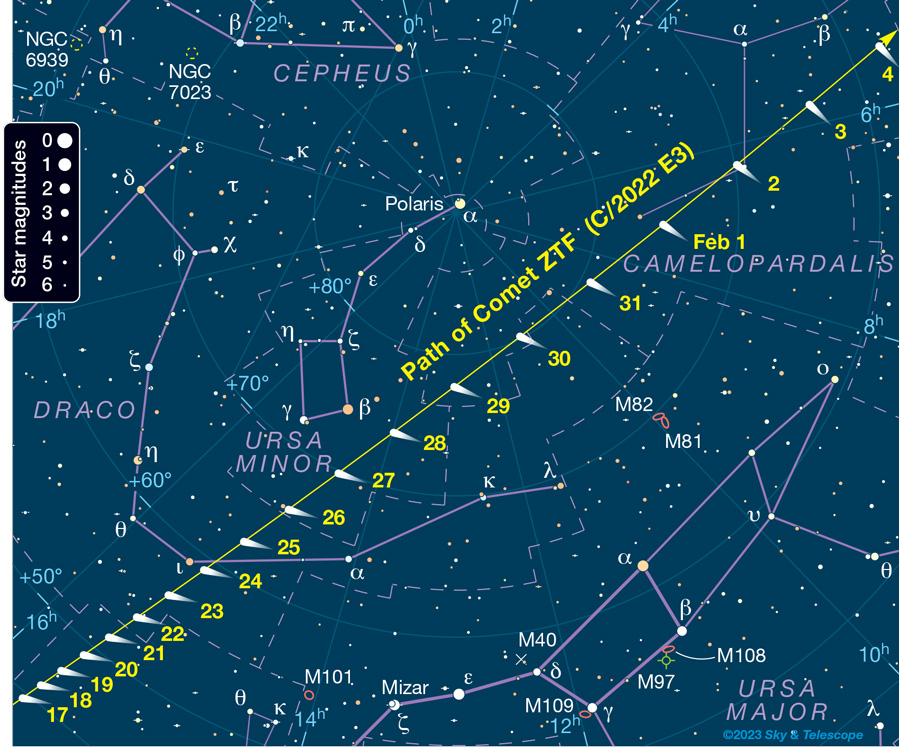
Sky & Telescope
Comet ZTF (C/2022 E3) is named for the Zwicky Transient Facility, a public-private partnership based at Caltech’s Palomar Observatory in California. Every two nights, a wide-field CCD camera attached to the 48-inch Samuel Oschin Telescope scans the entire northern sky in search of anything that blinks or moves. Among its quarry are near-Earth asteroids, thousands of supernovae (more than 6,600 classified to date), and numerous comets.
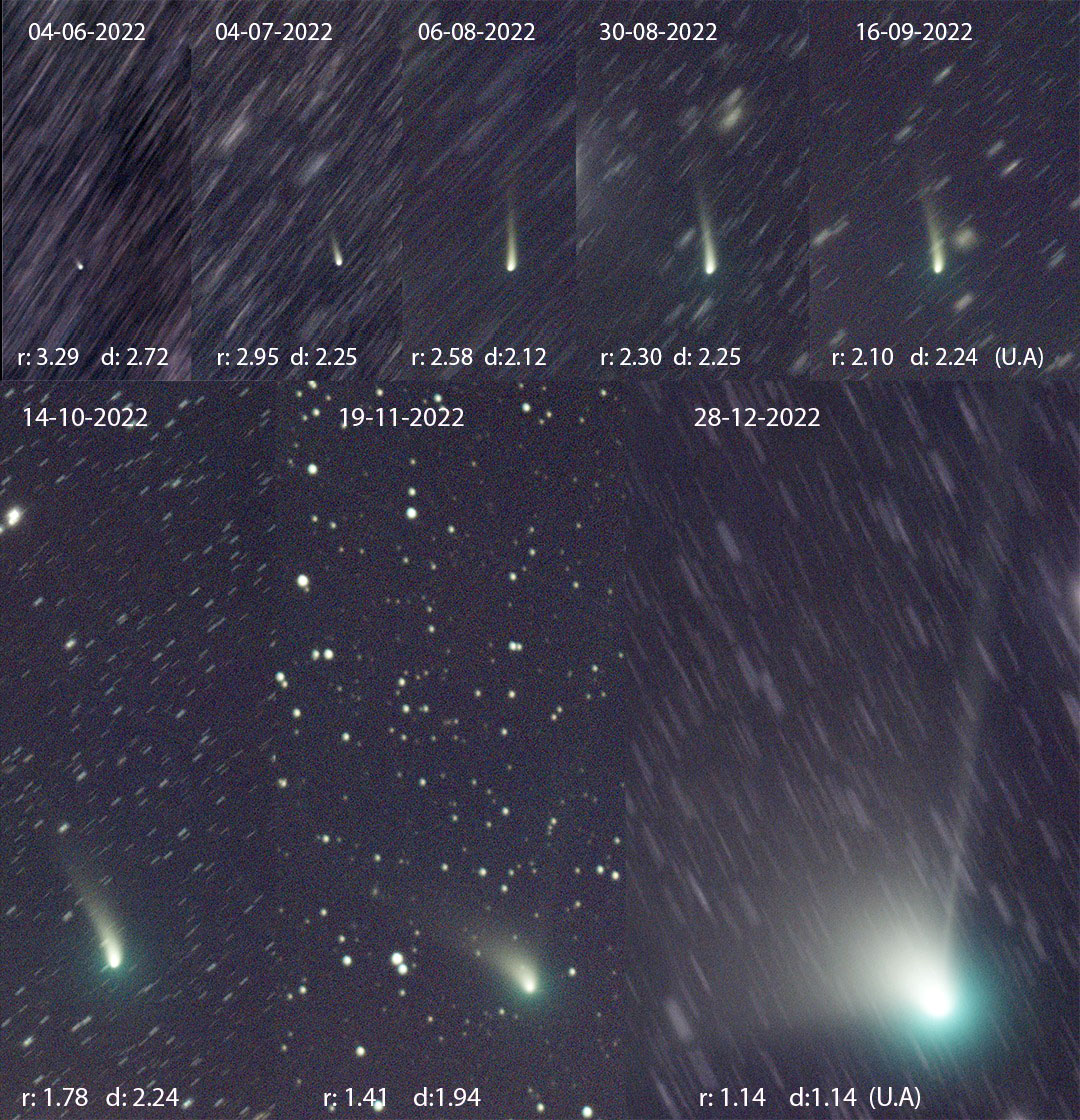
Dídac Mesa Romeu
C/2022 E3 was discovered on March 2, 2022, and initially reported as an asteroid candidate. One night later, Japanese observer Hirohisa Sato’s photographs of the object revealed a small coma, changing its status to a comet. More observations by additional observers confirmed Sato’s report. At the time, the 17th-magnitude speck was nearly 5 astronomical units from Earth, nearly identical to Jupiter’s average distance from the Sun.
On January 16–17, you’ll find our fuzzy friend in northeastern Boötes headed northwest at around 1.5° per day. Closest approach to Earth occurs on February 1st, when the comet will whiz past at 42 million kilometers (26 million miles). Perihelion (closest approach to the Sun) occurred on January 12th at 166 million kilometers (103 million miles). While its inbound period was 53,000 years, due to perturbations by the planets ZTF is now headed out of the solar system altogether. Perhaps one day the peripatetic puffball will become another star system's first interstellar comet.
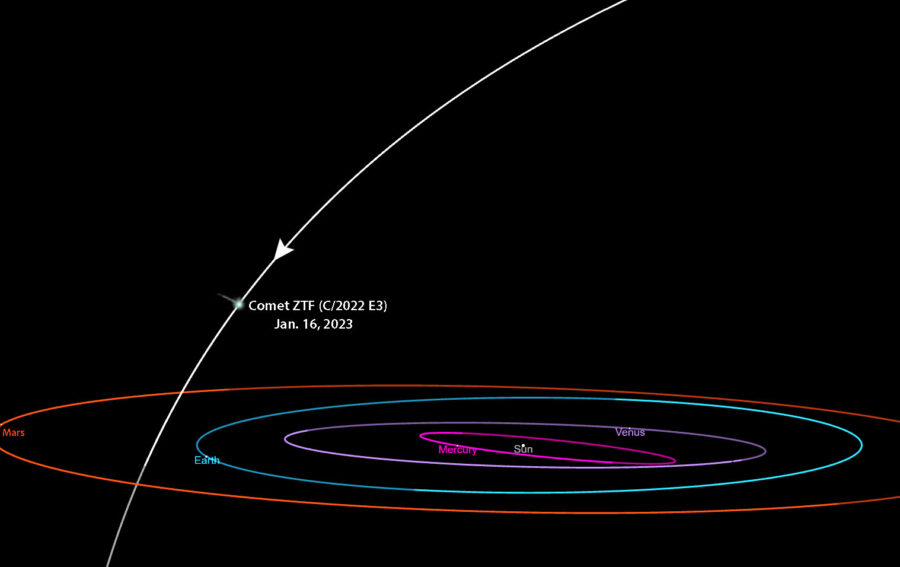
NASA HORIZONS
As Comet ZTF E3 closes in on our planet in the coming weeks, its apparent motion across the northern sky and altitude increase quickly. The comet becomes a circumpolar object for the northern states and Canada around January 17th and for the rest of the continental U.S. on January 25th. Come month’s end, Comet ZTF will be trucking along at the rate of 6.5° a day! That’s better than ¼° per hour, making its motion relative to the background stars obvious through a telescope after just a few minutes. Even 10× binoculars will reveal movement in an hour or two.
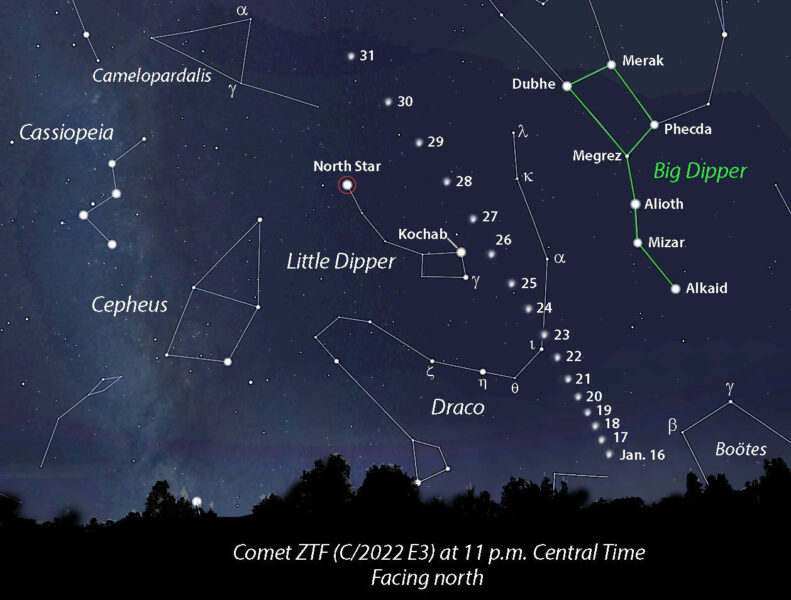
Stellarium with additions by Bob King
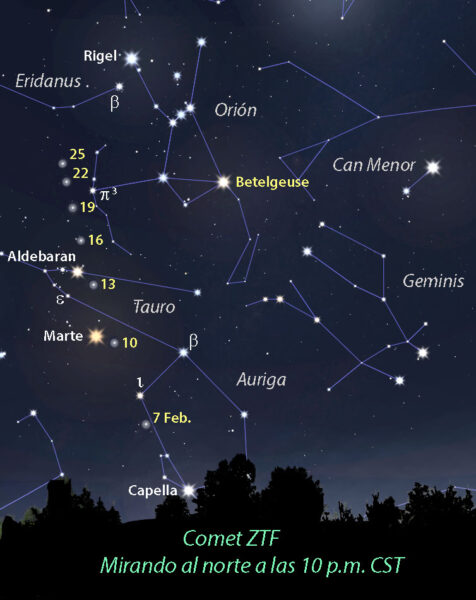
Stellarium with additions by Bob King
From latitude 40° north the comet stands 10° high in the northeastern sky on the night of January 16–17 at local midnight. That improves to 21° five nights later on January 21st. During much of January, observers in the northern U.S. will see the comet higher up earlier in the night compared to those in the southern part of the country, where the best views will be after 2 a.m. local time. Viewing becomes more equitable across the U.S. by late January when the object will be circumpolar for everyone. The table below addresses Comet ZTF’s continually changing circumstances as it climbs higher and higher while playing tag with the Moon.
| Dates | Comet 25° or higher, minimal Moon | Moon phase |
| Jan. 16–24 | Midnight till dawn | Waning crescent to waxing crescent |
| Jan. 24 | 11 p.m. till dawn | Waxing crescent |
| Jan. 25 | 10 p.m. till dawn | " " |
| Jan. 26 | 9 p.m. till dawn | " " |
| Jan. 27–28 | 7 p.m. till dawn | " " |
| Jan. 29–Feb. 2 | Early morning hours after moonset | First quarter to waxing gibbous |
| Feb. 3–5 | Moon interferes all night | Waxing gibbous to full Moon |
| Feb. 6–22 | Moonless window opens again — evening hours | Waning gibbous to waxing crescent |
First-quarter phase occurs on January 28th, when the Moon will set around 12:30 a.m. (on January 29th). A half-moon isn’t much of a comet-killer especially when it shines at the opposite end of the sky. However, by month’s end, the waxing gibbous Moon in Taurus and then Gemini will diminish the comet’s appearance if you plan to observe it before midnight. Fortunately, the Moon sets in the wee hours through February 2nd, leaving dark-sky windows to observe and photograph the bearded visitor at its closest and brightest.
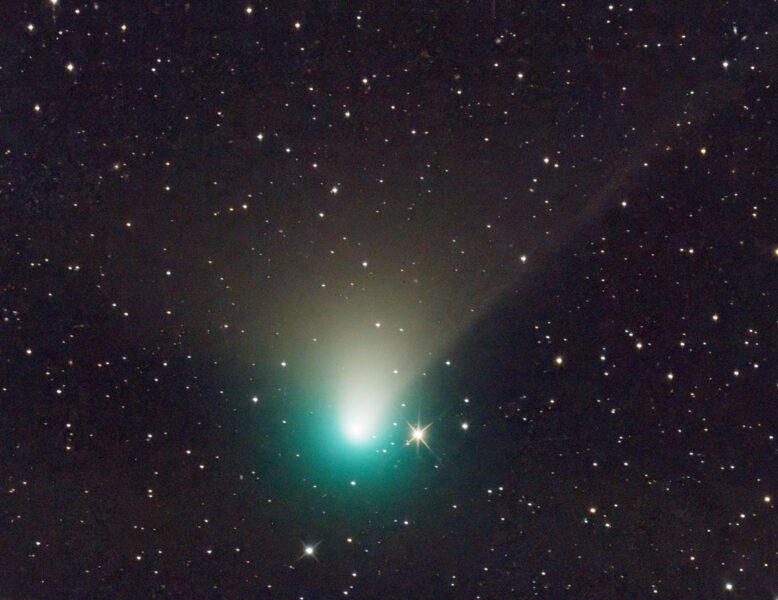
Juanjo Gonzalez
By early February the comet is firmly ensconced in the evening sky. It slides about 1.5° southwest of Capella on the evening of February 5th, the night of full Moon. The following evening it brushes Zeta (ζ) Aurigae in the Kids asterism. While the compact nuclear region will miss the star by ~10′, the fluffy coma may temporarily engulf it. Mars gets a visit on the night of February 10–11 when the comet cruises about 1.5° northeast of the planet for observers in the eastern half of the Americas. West Coast viewers will see them just 1° apart. The two bodies, one golden-orange, the other green and turquoise, should make a fine color contrast in time-exposure photos. Come Valentine’s Day (February 14th), Comet ZTF will have faded to about magnitude 7.0 and glow in a moonless sky around 1.5° east of Aldebaran in Taurus.
Then it’s back to the Oort Cloud for this interloper. Like most comets from this distant realm, its C/2022 E3's first journey to the inner solar system, and we'll likely never see it again. So don’t forget to wave “goodbye!” You can stay abreast of the comet’s magnitude, coma diameter, and more at the Comet Observation Database (COBS). Click on the Recent Observations link, then search for C/2022 E3. Another excellent source is Weekly Information about Bright Comets. Happy hunting!
Comments
Post a Comment